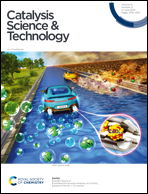Gold-catalyzed domino cyclization to diverse polyheterocyclic frameworks: mechanism, origin of the cooperative hydrogen bond, and role of π-stacking interactions†
Abstract
The detailed mechanism and origins of gold-catalyzed domino cyclization to diverse fused polyheterocyclic frameworks by cooperative catalysis and cascade catalysis were studied systematically. Specifically, different from cascade catalysis mechanisms proposed previously, the gold-counterion dual catalysis mechanism was the most plausible mechanism for domino cyclization because of its cooperative hydrogen bond, low activation energy, and favorable π-stacking stabilization interactions in transition states (TSs) and intermediates. Based on the Curtin–Hammett principle, the calculated activation energy of 33.3 kcal mol−1 was the rate-determining step for the overall reaction. Besides, the energy profiles for three different models (i.e. catalysts without the OTf− counterion or BF4− counterion; use of (benzo)furans and pyrroles as substrates; modification of the substrate's phenol group by a substituent) were investigated to confirm the interplay of cooperative hydrogen bonds and π-stacking stabilization interactions in a cooperative dual catalysis mechanism. Thus, the obtained theoretical results not only rationalized the experimental results, but also provided insights into the details of the domino cyclization.



 Please wait while we load your content...
Please wait while we load your content...